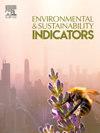社会生态系统视角下中国城市规模碳排放的经济与生态不平等随时间而加剧
IF 5.4
Q1 ENVIRONMENTAL SCIENCES
引用次数: 0
摘要
了解中国碳时空不平等对指导生态战略和跨区域能源利用具有重要意义。然而,同时考察中国城市碳排放的经济不平等和生态不平等的研究仍然很少。本文采用多区域投入产出模型、贸易相关条件和基尼系数,量化了2012 - 2017年中国城市碳排放经济效益和生态禀赋的不平等变化。研究发现:(1)中国碳排放的经济不平等加剧。具体而言,2012年,总增加值排名后20%的城市占二氧化碳排放总量的39%,2017年这一比例上升至44%。(2)碳排放方面的生态不平等依然存在,EcoNPP(生态系统中留存的净初级生产力,衡量碳固存能力)占总量20%的地区占全球二氧化碳排放总量的91%。本研究通过整合城市尺度上的经济效益和生态禀赋,为碳不平等提供了一个全新的双重视角,观察到的不平等凸显了许多中国城市在实现可持续发展目标8.2(促进经济增长和高效就业)和可持续发展目标12.2(实现可持续管理和资源利用)方面面临的重大挑战,这些目标对实现碳中和至关重要。本文章由计算机程序翻译,如有差异,请以英文原文为准。
Economic and ecological inequality of urban scale carbon emissions aggravated over time in China from a social-ecological system perspective
Understanding the spatiotemporal carbon inequality in China is crucial for guiding ecological strategies and energy utilization across regions. However, there are still few studies simultaneously investigating economic and ecological inequalities of urban carbon emissions in China. Here, employing a multi-regional input-output model, trade-related terms, and the Gini coefficient, we quantified the changes in inequality in economic benefits and ecological endowment of urban carbon emissions in China from 2012 to 2017. We found that: (1) Economic inequality of carbon emissions has increased in China. Specifically, cities in the bottom 20% of the total value added accounted for 39% of the total CO2 emissions in 2012, which increased to 44% in 2017. (2) Substantial ecological inequality in carbon emissions persisted, as regions with a 20% share of EcoNPP (net primary productivity that remains in ecosystems, a measure of carbon sequestration capacity) accounted for 91% of CO2 emissions. This study provides a novel dual perspective on carbon inequality by integrating economic benefits and ecological endowments at the urban scale, and the observed inequality underscores the significant challenges many Chinese cities face in achieving Sustainable Development Goals (SDG) 8.2 (promoting economic growth and efficient employment) and SDG 12.2 (achieving sustainable management and resource use), which are essential to the achievement of carbon neutrality.
求助全文
通过发布文献求助,成功后即可免费获取论文全文。
去求助
来源期刊

Environmental and Sustainability Indicators
Environmental Science-Environmental Science (miscellaneous)
CiteScore
7.80
自引率
2.30%
发文量
49
审稿时长
57 days
 求助内容:
求助内容: 应助结果提醒方式:
应助结果提醒方式:


